Wellington
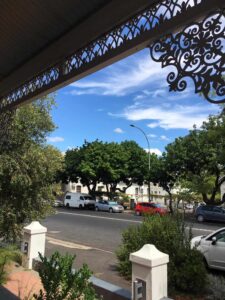
Limiet Valley
Val du Charron
Wagenmakersvallei
We’ve always preferred ‘the road less taken’.
And the same applies to wine country. Away from the well marketed estates, there are other, less visited farms producing a range of wines.
And so we travelled to Wellington, just north of Paarl, at the divergence of the Berg and Komme Rivers. The town is about 55km inland from the Atlantic coast, where cool, coastal winds to the region help to regulate the warm temperatures.
We started our Wellington journey at Imbuko Wines. The atmosphere was very relaxed and the tasting room and restaurant was full of local people, not tourists. We were welcomed with a glass of their Rosé.
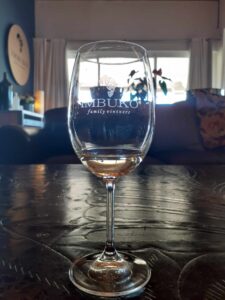
This was followed by a unique ‘pie and wine’ pairing.
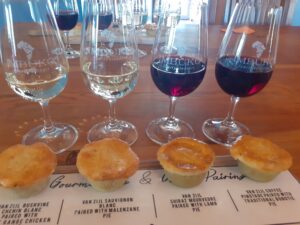
More wine awaited us at our cottage, where the owner of the wine estate had left us a bottle of wine as a welcome gift. We settled in at our comfy cottage, with everything provided for us to braai, swim and relax.
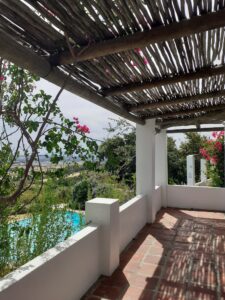
The stoep, affording views of the vines and the hills around Wellington, was the perfect place to watch the sunset. And nothing beats a sunset in Africa.
A highlight of our second day was lunch at Diemiersfontein, a large estate, accompanied by four of their flagship wines; an old vines Chenin blanc, the Thokozani, their excellent Malbec, and their unique Coffee Pintoage, the original coffee Pinotage in South Africa. We were pleased to hear more about the Thokozani. Staff from the estate have a stake in the success of this wine, made from 100% Cabernet Franc grapes.
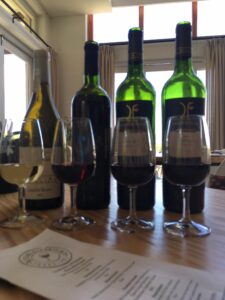
On our third day the plan was take a long drive up Bainskloof Pass. Time ran away with us and suddenly we were hungry, with no lunch reservation anywhere. We grabbed lunch at a place on the edge of town, where Springbok were grazing in a field.
We ordered Ukrainan dumplings, an unexpected find in this small town in South Africa’s Western Cape but we thought, why not?!
We continued.
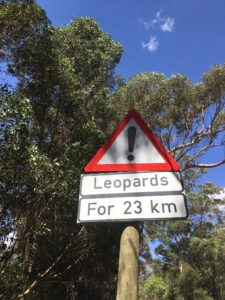
We passed a road sign for leopards. Knowing that a leopard sighting was unlikely during the daytime, we simply set off in search of adventure.
We began our ascent up the pass. Bainskloof Pass was the first pass built through to the hinterland by Andrew Geddes Bain in 1853. The scenery around Wellington is stunning.
After a little while, a larger vehicle was pulling up to our bumper, so we slowed down and pulled over to allow them to pass. But they stopped too, with news that we wouldn’t be able continue up the pass for much longer, as there was a bush fire raging nearby.
Undeterred we continued for a while, and stopped to take in the views before turning around.

There was still time for more wine.
We called in at Wellington Wines on Bainskloof Road, which features a wide range of wines produced by a co-operative, with tastes and prices to suit everyone. The biggest surprise was the Duke White Pinotage. We first came to know Pinotage over twenty years ago but never a white one. Apparently there are only six wine estates in SA to produce it. It was a really good wine, smooth on the palate with notes of cherries, summer berries and some cinnamon on the nose. We bought some to carry home and look forward to pairing it with a creamy pasta dish.
The low point of our day was a flat tyre, thanks to a Fever Tree thorn embedded in the rubber. The highlight was the wine tasting at our accommodation, ‘Druk My Niet’ Estate. The wine maker Marcus Milner was so warm and welcoming and we spent time together talking about life and travel. Occasionally the conversation turned back to wine.
His wines are excellent.
On our final day we left Druk My Niet Estate. The farm workers waved us goodbye, pausing for a moment from the busy labour of harvesting. It’s such an exciting time, with a flurry of activity on the wine estates, the noise of machinery, the workers chatting while gathering the grapes from the vines, then loading and unloading their crop. We wait in anticipation of the future vintages that will fill our glasses.
We drove to the centre of the town and took time to see some of the old part of Wellington. We set off in search of Stroopwafels and settled for savoury muffins at a lovely cafe in a heritage building on Church Street.
The imposing church at the top of the street features a statue of the theologian Andrew Murray. Quaint shops and beautiful historic buildings line the street, as well as the Victoria Jubilee Park with an impressive gateway.
And then we followed the signs out of town for ‘Kaapstad’.
We took a few days to explore Wellington, a wine route that we had never spent much time in before. Over 4 days we tried around 30 wines.
Today is a special day. South Africa is the only country in the world that can accurately pinpoint the exact date of origin for its wine industry, recorded in a diary entry on 2 February 1659. That’s 365 years of wine making!
Cheers to all the brilliant wine makers who share their craft and passion with us. And hooray for all the award-winning South African wines!
There’s many more to try.
Which wine region would you recommend to travel to?
Maggie M /Mother City Time